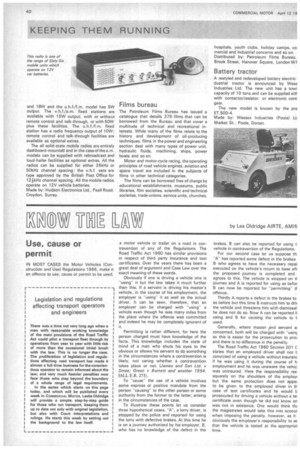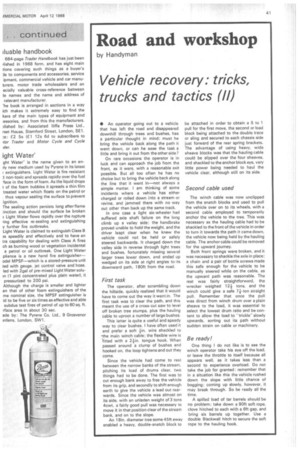MOM
Page 42

Page 43

If you've noticed an error in this article please click here to report it so we can fix it.
by Les Oldridge AIRTE, AMIN
Use, cause or permit
IN MOST CASES the Motor Vehicles (Construction and Use) Regulations 1966, make it an offence to use, cause or permit to be used, a motor vehicle or trailer on a road in contravention of any of the Regulations. The Road Traffic Act 1960 has similar provisions in respect of third party insurance and test certificates. Over the years there has been a great deal of argument and Case Law over the exact meaning of these words.
Obviously if one is driving a vehicle one is "using" it but the law takes it much further than this. If a servant is driving his master's vehicle, in the course of his employment, the employer is "using" it as well as the actual driver. It can be seen, therefore, that an employer can be charged with "using" a vehicle even though he was many miles from the place where the offence was committed and indeed he may be completely ignorant of it.
Permitting is rather different, for here the person charged must have knowledge of the facts. This knowledge includes the state of mind of a man who shuts. his eyes to the obvious or allows his servant to do something in the circumstances where a contravention is likely, not caring whether a contravention takes place or not. (James and Son Ltd. v Smee; Green v Burnett and another 1954. 3A1,1, E.R. 273).
To -cause" the use of a vehicle involves some express or positive mandate from the person "causingto the other person or some authority from the former to the latter, arising in the circumstances of the case.
To illustrate these points let us consider three hypothetical cases. "A", a lorry driver, is stopped by the police and reported for using the lorry with defective brakes. At this time he is on a journey authorized by his employer, B, who has no knowledge of the defect in the brakes. B can also be reported for using t vehicle in contravention of the Regulations.
For our second case let us suppose th. "A" has reported some defect in the brakes B who agrees to have the necessary repai executed on the vehicle's return to base aft the proposed journey is completed and agrees to this. The vehicle is stopped on tt journey and A is reported for using as befor B can now be reported for "permitting" ti offence.
Thirdly A reports a defect in the brakes to as before but this time B instructs him to dri% the vehicle and threatens him with dismissal he does not do so. Now A can be reported fi using and B for causing the vehicle to t used.
Generally, where master and servant ai concerned, both will be charged with "usinc as this is easier for the prosecution to pro% and there is no difference in the penalty.
The Road Traffic Act 1960 Section 201 states that an employed driver shall not convicted of using a vehicle without insuranc if he was using it during the course of h employment and he was unaware the vehic was uninsured. Here the responsibility res• squarely on the shoulders of the employ( but the same protection does not appei to be given to the employed driver in th case of test certificates and he would prosecuted for driving a vehicle without a tei certificate even though he did not know on was not in existence. One would think tiN the magistrates would take this into accour when imposing the penalty, however, as it obviously the employer's responsibility to se that the vehicle is tested at the appropriat time.
Iluable handbook
684-page Trader Handbook has just been ■ lished in 1968 form, and has eight main tions covering such things as a buyer's Je to components and accessories, service ipment, commercial vehicle and car menuturers, motor trade wholesalers and an ecially valuable cross-reference between le names and the name and address of relevant manufacturer.
'he book is arranged in sections in a way ich makes it extremely easy to find the kers of the main types of equipment and essories, and from this the manufacturers, )1ished by: Associated Iliffe Press Ltd., rset House, Stamford Street, London, SE1. 3e: £2 5s (£1 12s 6d to subscribers to ■ tor Trader and Motor Cycle and Cycle der.
ight Water'
ght Water" is the name given to an en:1y new medium used by Pyrene in its latest extinguishers. Light Water is fire resistant I non-toxic and spreads rapidly over the fuel lace in the form of foam. As the liquid drops t of the foam bubbles it spreads a thin film treated water which floats on the petrol or thus vapour sealing the surface to prevent ignition.
The sealing action persists long afterflame :inction and should the surface be broken Light Water flows rapidly over the rupture ring effective re-sealing and extinguishing y further fire outbreaks.'
Light Water is claimed to extinguish Class B 3S speedily and effectively and to have an Era capability for dealing with Class A fires ch as burning wood or vegetation incidental a petrol or oil outbreak. One Light Water pliance is a new hand fire extinguisherodel MPSF—which is a stored-pressure unit Led with gauge, jet control valve and hose. led with 2gal of pre-mixed Light Water soluin (1 pint concentrated plus plain water), it pressurized to 200 psi.
Although the charge is smaller and lighter an that of other foam extinguishers of the me nominal size, the MPSF extinguisher is id to be five or six times as effective and able subdue test fires of petrol of up to BO sq. ft. rface area in about 30 sec.
ade by: The Pyrene Co. Ltd.. 9 Grosvenor irdens, London, SW1.




































































































